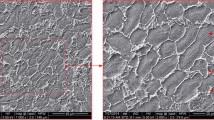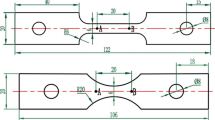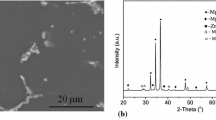Abstract
The plastic deformation mechanisms and the constitutive model of flow behaviors at different deformation conditions in biomedical titanium alloy are an essential step to optimize the design of any forging process for implant productions. A series of isothermal compressions tests on Ti-13Nb-13Zr alloy in a wide range of true strain, temperature and strain rate were conducted on a thermomechanical simulator. The hot flow behaviors with different softening mechanisms, including dynamic recrystallization and dynamic recovery, were characterized based on true strain-stress curves. A back-propagational artificial neural network (BP-ANN) method was conducted to evaluate and predict this non-linear problem by self-training to be adaptable to the material characteristics. The flow stress of this material a wide deformation condition range can be predicted accurately by the BP-ANN model obtained in this study. The prediction ability of this BP-ANN Model was evaluated by three accuracy indexes, Absolute error, Relative error and Average absolute relative error. Sequently, the developed BP-ANN model was programed and implanted into the finite element (FE) analysis platform, Msc.Marc software. The results have sufficiently articulated that the well-trained ANN model has excellent capability to deal with the complex flow behaviors and has great application potentiality in hot deformation processes.
Similar content being viewed by others
References
Chen, Q. and Thouas, G. A., “Metallic Implant Biomaterials,” Materials Science and Engineering: R: Reports, Vol. 87, pp. 1–57, 2015.
Thieme, M., Wieters, K.-P., Bergner, F., Scharnweber, D., Worch, H., et al., “Titanium Powder Sintering for Preparation of a Porous Functionally Graded Material Destined for Orthopaedic Implants,” Journal of Materials Science: Materials in Medicine, Vol. 12, No. 3, pp. 225–231, 2001.
Bordji, K., Jouzeau, J. Y., Mainard, D., Payan, E., Netter, P., et al., “Cytocompatibility of Ti-6Al-4V and Ti-5Al-2.5 Fe Alloys according to Three Surface Treatments, using Human Fibroblasts and Osteoblasts,” Biomaterials, Vol. 17, No. 9, pp. 929–940, 1996.
Thair, L., Mudali, U. K., Rajagopalan, S., Asokamani, R., and Raj, B., “Surface Characterization of Passive Film Formed on Nitrogen Ion Implanted Ti-6Al-4V and Ti-6Al-7Nb Alloys using Sims,” Corrosion science, Vol. 45, No. 9, pp. 1951–1967, 2003.
Niinomi, M., Nakai, M., and Hieda, J., “Development of New Metallic Alloys for Biomedical Applications,” Acta Biomaterialia, Vol. 8, No. 11, pp. 3888–3903, 2012.
Gepreel, M. A.-H. and Niinomi, M., “Biocompatibility of Ti-Alloys for Long-Term Implantation,” Journal of the Mechanical Behavior of Biomedical Materials, Vol. 20, pp. 407–415, 2013.
Navarro, M., Michiardi, A., Castano, O., and Planell, J., “Biomaterials in Orthopaedics,” Journal of the Royal Society Interface, Vol. 5, No. 27, pp. 1137–1158, 2008.
Lee, Y.-S., Niinomi, M., Nakai, M., Narita, K., and Cho, K., “Predominant Factor Determining Wear Properties of ß-type and (α +ß)-Type Titanium Alloys in Metal-to-Metal Contact for Biomedical Applications,” Journal of the Mechanical Behavior of Biomedical Materials, Vol. 41, pp. 208–220, 2015.
Akahori, T., Niinomi, M., Fukui, H., Ogawa, M., and Toda, H., “Improvement in Fatigue Characteristics of Newly Developed Beta Type Titanium Alloy for Biomedical Applications by Thermo-Mechanical Treatments,” Materials Science and Engineering: C, Vol. 25, No. 3, pp. 248–254, 2005.
Henriques, V. A. R., Galvani, E. T., Petroni, S. L. G., Paula, M. S. M., and Lemos, T. G., “Production of Ti-13Nb-13Zr Alloy for Surgical Implants by Powder Metallurgy,” Journal of Materials Science, Vol. 45, No. 21, pp. 5844–5850, 2010.
Müller, F. A., Bottino, M. C., Mü ller, L., Henriques, V. A., Lohbauer, U., et al., “In Vitro Apatite Formation on Chemically Treated (P/M) Ti-13Nb-13Zr,” Dental Materials, Vol. 24, No. 1, pp. 50–56, 2008.
Quan, G.-Z., Li, G.-S., Wang, Y., Lv, W.-Q., Yu, C.-T., and Zhou, J., “A Characterization for the Flow Behavior of as-Extruded 7075 Aluminum Alloy by the Improved Arrhenius Model with Variable Parameters,” Materials Research, Vol. 16, No. 1, pp. 19–27, 2013.
Basheer, I. A. and Hajmeer, M., “Artificial Neural Networks: Fundamentals, Computing, Design, and Application,” Journal of Microbiological Methods, Vol. 43, No. 1, pp. 3–31, 2000.
Quan, G.-Z., Lv, W.-Q., Mao, Y.-P., Zhang, Y.-W., and Zhou, J., “Prediction of Flow Stress in a Wide Temperature Range Involving Phase Transformation for as-Cast Ti-6Al-2Zr-1Mo-1V Alloy by Artificial Neural Network,” Materials & Design, Vol. 50, pp. 51–61, 2013.
Singh, S., Vashishtha, V., and Singla, T., “Artificial Neural Network,” International Journal of Research, Vol. 1, No. 9, pp. 934–942, 2014.
Cheng, L., Chang, H., Tang, B., Kou, H. C., and Li, J. S., “Flow Stress Prediction of High-Nb Ti Al Alloys under High Temperature Deformation,” Advanced Materials Research, pp. 723–728, 2012.
Ma, X., Zeng, W., Sun, Y., Wang, K., Lai, Y., and Zhou, Y., “Modeling Constitutive Relationship of Ti17 Titanium Alloy with Lamellar Starting Microstructure,” Materials Science and Engineering: A, Vol. 538, pp. 182–189, 2012.
Kotkunde, N., Deole, A. D., Gupta, A. K., and Singh, S. K., “Comparative Study of Constitutive Modeling for Ti-6Al-4V Alloy at Low Strain Rates and Elevated Temperatures,” Materials & Design, Vol. 55, pp. 999–1005, 2014.
Srinivasu, G., Rao, R. N., Nandy, T. K., and Bhattacharjee, A., “Artificial Neural Network Approach for Prediction of Titanium Alloy Stress-Strain Curve,” Procedia Engineering, Vol. 38, pp. 3709–3714, 2012.
Sun, Y., Hu, L., and Ren, J., “Modeling the Constitutive Relationship of Powder Metallurgy Ti-47Al-2Nb-2Cr Alloy during Hot Deformation,” Journal of Materials Engineering and Performance, Vol. 24, No. 3, pp. 1313–1321, 2015.
Quan, G.-Z., Liang, J.-T., Lv, W.-Q., Wu, D.-S., Liu, Y.-Y., Luo, G.-C., and Zhou, J., “A Characterization for the Constitutive Relationships of 42CrMo High Strength Steel by Artificial Neural Network and Its Application in Isothermal Deformation,” Materials Research, Vol. 17, No. 5, pp. 1102–1114, 2014.
Quan, G.-Z., Yu, C.-T., Liu, Y.-Y., and Xia, Y.-F., “A Comparative Study on Improved Arrhenius-Type and Artificial Neural Network Models to Predict High-Temperature Flow Behaviors in 20 MnNiMo Alloy,” The Scientific World Journal, Vol. 2014, Article ID: 108492, 2014.
Zhu, Y., Zeng, W., Sun, Y., Feng, F., and Zhou, Y., “Artificial Neural Network Approach to Predict the Flow Stress in the Isothermal Compression of As-Cast TC21 Titanium Alloy,” Computational Materials Science, Vol. 50, No. 5, pp. 1785–1790, 2011.
Gupta, A. K., Singh, S. K., Reddy, S., and Hariharan, G., “Prediction of Flow Stress in Dynamic Strain Aging Regime of Austenitic Stainless Steel 316 using Artificial Neural Network,” Materials & Design, Vol. 35, pp. 589–595, 2012.
Chai, R.-X., Guo, C., and Yu, L., “Two Flowing Stress Models for Hot Deformation of XC45 Steel at High Temperature,” Materials Science and Engineering: A, Vol. 534, pp. 101–110, 2012.
Mandal, S., Rakesh, V., Sivaprasad, P., Venugopal, S., and Kasiviswanathan, K., “Constitutive Equations to Predict High Temperature Flow Stress in a Ti-Modified Austenitic Stainless Steel,” Materials Science and Engineering: A, Vol. 500, No. 1, pp. 114–121, 2009.
Vickram, A. S., Das, R., Srinivas, M. S., Rao, K. A., Jayaraman, G., and Sridharan, T., “Prediction of Zn Concentration in Human Seminal Plasma of Normospermia Samples by Artificial Neural Networks (ANN),” Journal of Assisted Reproduction and Genetics, Vol. 30, No. 4, pp. 453–459, 2013.
Author information
Authors and Affiliations
Corresponding author
Rights and permissions
About this article
Cite this article
Quan, Gz., Pu, Sa., Zhan, Zy. et al. Modelling of the hot flow behaviors for Ti-13Nb-13Zr alloy by BP-ANN model and its application. Int. J. Precis. Eng. Manuf. 16, 2129–2137 (2015). https://doi.org/10.1007/s12541-015-0275-y
Received:
Revised:
Accepted:
Published:
Issue Date:
DOI: https://doi.org/10.1007/s12541-015-0275-y




